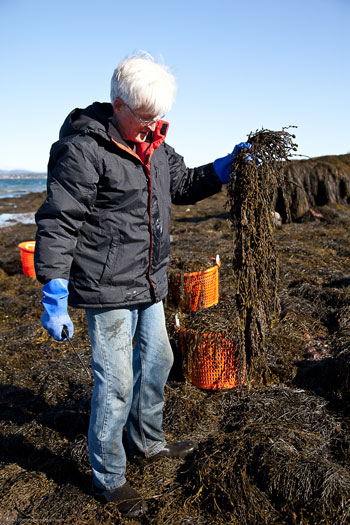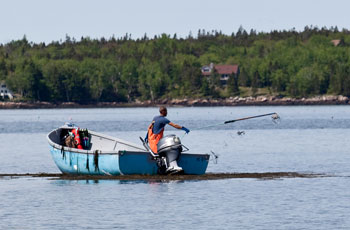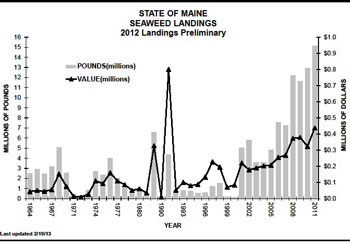Rockweed Booms, Who Benefits?
by Paul Molyneaux

Larch Hanson, Gouldsboro, Maine. Hanson has been harvesting the same seaweed beds for 40 years. Paul Molyneaux photo
I have a friend, born and raised on the shores of Cobscook Bay, who started harvesting rockweed around 2008. “My parents sent me to school, sent me to college, educated me and all that, but how come nobody told me about this?!” she said, as the experience of working outside among the tides, feeling the pull of the moon and the rockweed, all drew her into a heightened awareness of herself and her surroundings. She became a woman transformed, reveling in a newfound strength and ability. Her employer, Acadian Seaplants Limited (ASL), a Nova Scotia based multinational rockweed exporter, increased her responsibilities, seeking to capitalize on her passion. “They wanted me to train all their new crews, but they didn’t want to pay me what I thought it was worth,” she said. After only two years she quit the business, unable to reconcile her renewed appreciation of herself and her home waters with ASL’s business model.
“To make money in Maine, we want to expand beyond Jonesport and Cobscook Bay,” ASL’s Rex Hunter said in a 2009, Bangor Daily News article. “We are looking at the entire coastline of Maine, looking at the biomass perspective. We are not investing in other areas for several years. We are just investigating expansion.”
Rockweed harvesting has seen significant expansion in the last decade. In the ten years prior to ASL’s entry into the Maine rockweed harvest in 1999, a handful of companies harvested an average of 1 million pounds of rockweed per year. But by 2002, the harvest had jumped up to 5 million pounds and has climbed to 15 million pounds since then. Still, Maine rockweed harvesters have barely tapped the resource. “Ireland harvested more rockweed in 1807, than Maine did in 2012,” said George Seaver, who has been in the business since 1977, and now owns Ocean Organics, which processes rockweed into a fertilizer. “Right now all the companies together are harvesting less than 1 percent of the biomass.”
But with the harvest and value of rockweed increasing. Pat Keliher, commissioner of Maine’s Department of Marine Resources (DMR), convened a Plan Development Team (PDT), and instructed it to come up with a rockweed fisheries management plan (FMP). In January 2014, the PDT, comprised of three industry members, including Seaver, two environmentalists, three academics (one of whom works for ASL) and representatives of the DMR, and Sea Grant, concluded its work on a rockweed fisheries management plan (FMP) that it believes will guarantee a sustainable harvest. But questions have been raised about the credibility of the PDT, particularly its science, and its plan to give ASL and a few Maine companies unprecedented control over the resource.
Some of the harshest criticism comes from Dr. Robin Seeley, who was denied a seat on the PDT, but attended most of the meetings as a representative of The Rockweed Coalition, a consortium or shorefront property owners and fishermen intent on preserving rockweed ecosystems. “Have you seen that they have Raul Ugarte on the PDT as an academic?” She asked. “He works for Acadian Seaplants.” To be fair, Ugarte, the chief Scientist at ASL, also holds an adjunct professorship at the University of New Brunswick.
“The PDT described itself as ‘well balanced,’” Seeley argued. “I assume this means that there was a balance between competing interests. But the PDT was not at all “well balanced”: the rockweed industry essentially had four seats at the table [Raul Ugarte, ASL; George Seaver, Ocean Organics; Susan Domizi, Source Maine; and Dave Preston of North American Kelp] and those whose interests are strongly in favor of protecting habitat had two seats [Jane Arbuckle, Maine Coast Heritage Trust; and Nancy Sferra, Nature Conservancy]. I make that two to one. Not balanced.”
Linda Mercer, the DMR biologist who oversaw the work of the PDT said the process was inclusive. “The PDT invited three members from each stakeholder group. But not everyone responded. The panel ended up with three people from industry; three from academia; two people from Sea Grant; two people from the environmental community; three people from the DMR.” Mercer defended Ugarte’s inclusion as an academic. “He’s a scientist,” she argued. “He has written many research papers on rockweed.” The PDT lists four of those papers among those on which it based its recommendations.
Seeley felt many stakeholder groups were denied a meaningful role in the process, in particular, harvesters. “We felt that industry could communicate the concerns of the harvesters,” said Mercer. “The meetings were open and anyone could attend.”
“The [PDT] imbalance affected the process, and the process created the management plan,” said Seeley. Other local environmentalists echoed Seeley’s concerns in a group letter to the PDT that said: “any discussion of ‘sustainability’ that puts the focus on rockweed per se is inappropriate and needs to be replaced with a broader ecological values-based approach.”
Nonetheless, most members of the PDT felt ASL had demonstrated success in developing long term harvest regimes on a provincial scale. Rather than re-invent the wheel, the PDT lifted the key features of Maine’s rockweed FMP almost point by point from Acadian Seaplants’ New Brunswick harvest plan, (http://www.acadianseaplants.com/marine-plant-seaweed-manufacturers/resource-management). Regulations include: a 16-inch minimum cutting height, maximum 17 percent biomass removal, and sector management where the harvesters conduct their own stock assessments. While these measures have appeared to produce sustainable harvests in Canada, Seeley asked: “Sustainable for what? Industrial production, or entire ecosystems?” Seeley presented a list of at least 35 fish species—including commercially important cod, pollack, eel, flounder, mackerel and herring—that depend on rockweed for habitat.
In addition to pointing out the absence important stakeholders, such as fishermen, municipalities, and tribal representatives at the table, Seeley claimed the PDT had a low standard for science, particlularly in regard to a Department of Fisheries and Oceans science report critical of the Nova Scotia rockweed harvest. “ASL holds 75 percent of the leases and harvests 90 percent of the rockweed landed in Nova Scotia,” said Seeley. “After Raul Ugarte’s critique of the Canadian report, its conclusions were never brought up again at the PDT, to my knowledge, and the Canadian report is not cited in the Maine plan, let alone its conclusions discussed and heeded. Several times I asked the PDT to please clarify its quality standard for scientific information, because unpublished abstracts, reports, theses, and observations were given weight and cited, while published papers and other observations were ignored.”

Harvesting rock weed by throwing seaweed rake/cutter in shallow water. Paul Molyneaux photo
Larch Hanson, who people in the business either regard as the state’s most conscientious harvester, or an ideological thorn in their side, or both, also sought a seat on the PDT and was denied. “I presented my comments to the PDT regarding cutting heights,” said Larch. “I’ve been cutting the same beds for 40 years, but what do I know? The report recommends 16" cutting height, but that doesn’t leave enough stems for proper regeneration,” said Hanson, who recommends a 32” cut height. “Thirty-two inches maintains density and habitat while reducing the flow through the bed so that plants will not be torn loose under extreme wave conditions.”
“We did hear some comments that the cutting height should be higher, said PDT member, Nancy Sferra of the Nature Conservancy. “But then the companies said they would be forced to harvest from a wider area in order to get the volumes they needed, and several studies showed adequate recovery from a 16 inch cut, so we voted for that.” Sferra pointed out that the PDT did not always defer to the industry, choosing to opt for the precautionary principle instead. “Dr. Ugarte did mention that he thought the resource could withstand the removal of 25 percent of the biomass, but we stuck with 17 percent.”
Entities Get the Rockweed, Harvesters Get Jobs
While Maine’s DMR claimed to have learned from past mistakes, the rockweed plan appears to ignore some basic principles that have led to biological and socio-economic success in the lobster fishery. The lobster fishery limits technology to traps, only allows owner/operators to participate in the fishery, and restricts mobility within relatively small zones. This means the benefits of the harvest are more or less evenly distributed within communities, and fishermen take care of the local ecosystems they depend on.
The rockweed plan permits the unprecedented mechanical harvesting of a resource in the intertidal zone, and for the first time grants intertidal resource access to “entities” and their employees or sub-contractors, and puts no limits on the amount of shore line an “entity” can control.
In no other fishery in Maine are buyers given control of the resource and permitted to hire fishermen at wages or piecework. Resource access has almost always been reserved for independent owner/operators. When a market opens up for a product, entrepreneurial fishermen gear up and supply the demand. When loopholes appear, they get plugged, as in the sea urchin fishery, where boat owners could initially hold multiple dragging permits for multiple boats and put hired skippers to work. This was phased out in the late 1990’s, and permits limited to owner/operators.
“Creating jobs, as ASL promises, is different from creating independent owner/operators who grow to become entrepreneurs in their own right,” said Larch Hanson.
According to ASL’s Rex hunter, ASL hires harvesters as contractors, usually operating under their own licenses but with crews working under supplemental licenses, which existing regulations say can be issued to family and employees of primary license holders. ASL supplies the contractors with boats, equipment, and instructions on where to harvest.
George Seaver, who buys his rockweed from independent harvesters, pointed out that the Canadians guard their own domestic industry. “Interestingly, they only allow hand harvesting, to protect jobs,” said Seaver. “And rockweed harvested in New Brunswick has to be processed in New Brunswick.”
While accomodating the current structure of the industry, which includes the use of mechanical harvesters and permits the export of most of the rockweed harvest to Canada, Maine’s rockweed FMP does open the door for new entrants. Individuals can buy licenses and apply for sectors if they can complete a rockweed biomass assessment that can cost upwards of $10,000, or they agree to limit their harvest to 10 metric tons.
“We thought that would be fair,” said Nancy Sferra. “We thought that would meet the needs of both the high volume and small companies, and individuals. Our hope for everyone is for the plan to be adaptive, so that we can protect the rockweed as a resources and as habitat.”
Adaptation
While the rockweed harvest may be out of sync with other intertidal fisheries, buyers have long been pro-active in regulating the harvest. PDT member Susan Domizi co-founded the Maine Seaweed Council in 1993, and many harvesters, scientists and regulators belong to the group, which seeks to create a sustainable industry. Long time council members from Acadian Seaplants—which according to the website, panjiva.com, ships processed rockweed by the ton to companies in Japan, Singapore, Brazil, Chile, Germany, Mexico, and other countries—needs large quantities of low cost raw material, and wants to protect its expanding harvest in Maine. Processors like George Seaver needs only small amounts of carefully handled rockweed for specialty products for golf courses. But everyone in the business needs a level of regulatory and biological security to protect their investments, and the Maine Seaweed Council has been out front in creating that security.
People in the seaweed business generally exhibit passion beyond the profit motive, but only Larch Hanson, has offered a truly utopian vision of the industry. “I am not interested in distributing rockweed products worldwide, based on proprietary information. As an educator I find the term ‘proprietary information one of the most obscene phrases in the English language.” Citing an incident at an elementary school, where 25 students received extra food from the Maine Seacoast Mission and 40 percent of the students were on Food stamps, Hanson believes the nutrition in local rockweed should be going into local bellies. “I want people to learn how to sustainably harvest rockweed beds so that local soils will have increased fertility, and I want to teach gardening and greenhouse construction to people who are presently hungry.”
To that end Hanson has proposed allowing municipalities to manage their rockweed resources in a way similar to clam management. Towns would assign sectors to local harvesters and a rockweed warden would oversee compliance and collect fees from harvesters. In Hanson’s ideal scenario, harvesters would use only knives, and train as apprentices before being allocated their own sectors. “In the long run, I create more jobs. I extract more value per ton, and I am able to direct that value more efficiently back into the community. The block to progress now is the industry’s refusal to accept every harvester as an owner/operator, free to sell to anyone in a free-market economy.” According to Hanson, this kind of industry would create a much more “resilient local economy.”

“It is true that DMR walks a tightrope with respect to supporting the current seaweed industry’s need for certainty about access to the seaweed, without limiting personal access to the seaweed, or as importantly, a new business that wants to “stick its toe into the water,” said rockweed processor, Seaver. He offered a practical perspective in contrast to Hanson’s idealism. “When you move from the abstract goal of keeping the value of the harvest for the coastal residents, you tend to overlook how business really happens. Allocating sectors is conceptually driven by ecological considerations not economic ones,” he said. “Again- the art of this will be assigning sectors to ensure responsible harvesting and stable supply to established companies while not hindering new business ventures. However, it is not ever likely to be a matter of how close to the shore you live when it comes to deciding if you can ‘get’ a sector.”
As Shep Earhart, another long time seaweed buyer and distributor re-iterated, the FMP is adaptive. “Yes, owner/operators are the ideal. But I think the PDT had to start with what was already happening, so they chose “entities” to accommodate what is. I see this version of the FMP as Phase I of a multi-year project. After all it took the Canadians five years to get their rockweed management plan together.”
The comment period on the rockweed plan ended on January 13, it now goes to the state legislature’s Marine Resources Committee, then back to the DMR for rule making followed by public hearings.
